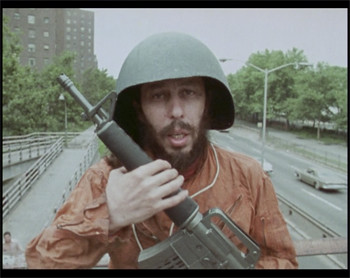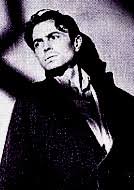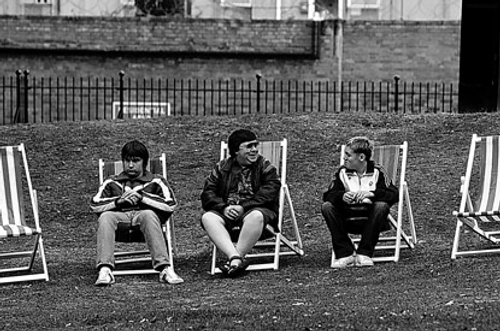Cinema might be the only medium that requires a great deal of fun to succeed. Fun in the sense that the discipline is already there; there is a certain amount of film or tape to be used, a certain continuity that must be retained and a certain amount of time one has. The fun must merely occur within this framework.
Goofing off is a form of play that should be condoned in most situations, but is acceptable, even endearing, in others. It is either a creative act at all times or a time-waster at all times. It is almost always acceptable after a bout of hard work, as a way of letting off steam. It is thought to be more acceptable in individuals who have already proven themselves tremendously in their respective fields, whereas if one spends his entire career either sleeping on the job or making prank calls, then he is a complete goofball. Someone who works hard at his job and occasionally cracks a joke with the boss is simply a disciplined worker with a human side.
Filmmakers are not spared these distinctions. Ed Wood was a goofball; Orson Welles showed he had a human side in F for Fake. One of the main differences is that most filmmakers are well-intentioned goofballs; Ed Wood thought he was making good films, he just wasn’t. Another difference is that when a great director or actor goofs-off their goofing off is supposed to retain eloquence and artfulness. Brando worked his heart out in A Streetcar Named Desire, The Godfather, Last Tango in Paris and Burn, then spent most of the rest of his career fooling around in films such as Apocalypse Now, The Island of Dr. Moreau and The Score. These performances were in fact just goofy-creepy or goofy-silly; still, Brando is in the minds of many an actor who could transcend the material he was given.
The double standards by which we view goofing-off are understandable in life, but not in filmmaking. In films, it is important that the director, actors and crew take the film seriously by actively goofing off. Filmmaking, like goofing-off, is a form of play that is also very hard work. By this measure, a finished film should not simply be half disciplined structure and half anarchic silliness. Ideally, the two should be indistinguishable.
If we step back and look at cinema as a whole, we can easily see the ways in which it is a goofy and ridiculous medium. Who would spend an amount of money greater than the cost of three or more large houses, gather a massive amount of equipment that wastes a wide variety of natural resources and then try to alter the natural environment of the shoot itself, simply to create a product that is only light projected on to a screen, and will probably be forgotten anyway? Why couldn’t they just write it instead, or paint it, or sing it? The silliness is there, but the overall resemblance of filmmaking to goofing off does not trivialize the importance of filmmaking. On the contrary: filmmakers should make all this effort and still act silly during the shoot itself. For this is one of the only ways to capture spontaneous moments, fleeting images, unexpected but perfect reactions from actors or extras, or incidental wildlife which heighten the mood of the film and give it a new texture. Perhaps these spontaneous or improvised moments, achieved by goofing off, will be the ones viewers remember best.
The films that are remembered for this particular sensibility are equally about goofing off as they were created by the act of it. Many of these films, unsurprisingly, are also comedies. Buster Keaton’s early films, including features such as Our Hospitality (1924) and shorts such as Cops (1922), were all expertly staged feats of silliness. Witnessing Keaton swing across a waterfall is to witness an act that is both sincere and ridiculous. More contemporary comedies, generally the slapstick ones-- i.e. Animal House, Dazed and Confused-- have plots that hinge on the outrageous behavior of the characters from scene to scene. John Belushi’s drunken antics and a group of teenager’s destruction of mailboxes are not condonable in real life, or on any other job; in movies, we know we aren’t supposed to approve, but they are still bliss. An unclassifiable, yet comic movie such as W.R: Mysteries of the Organism (1971) works basically the same way. A joyous image of cinematic goofiness comes in one scene when the singer Tuli Kupferberg, having been stalked around the streets of New York carrying a machine gun for some time, stands on a bridge passing over a highway and masturbates his gun, while jumping up and down, his grin widening. W.R is a different beast from Animal House and Dazed and Confused, far more of a critique than a comedy. But the scene is both unnerving and funny, which we laugh at despite our instincts that tell us we should be repelled, or scornful; a typical goof-off scene. These mixed instincts are at the heart of the appreciation of goofing off, in life and in films. Keaton, Animal House, Dazed and Confused and W.R each deliver this mixture, simply by making us watch the way the people on screen behave. In this sense, they are quintessential goof-off movies, but in another sense, that is all they do. They may be funny and their goofiness may be subversive on the most basic level, but it is only scratching the surface of that subversion.
For goofing off to be taken seriously as art, then, we have to look at the films that take the subversion a step further. These are films that use goofing off to disrupt our emotions entirely, rather than conceal the disruption with humor, as we would expect. This is similar to developing a negative image of a smiling mother holding her newborn son; we don’t want the scene to behave this way, but the effect is nonetheless fascinating. Stan Brakhage knew this when he produced Desistfilm (1954), a fine and unsettling eight-minute piece of goof-off art. Watch as a group of kids smoke, dance, make out, play with fire and have a very perverse type of fun in some cabin presumably in the woods. The camera wiggles, pulls in and out and moves in step with what the kids are doing at all moments; the sound goes from an annoying buzz to a mash-up of rock music and shouting; even the crew is participating in the foolishness. At the film’s end, a group of boys run around the back of the house to spy on their friend making out, intoxicated, with a pretty girl in a bedroom. The two lovers turn to the window and see the sniggering teenage faces lined up, watching them. With this ending, Desistfilm becomes a film about the limits of goofing off. If we were to witness this scene from the perspective of the teenagers doing the spying, we would probably feel a sensation close to how Animal House or Dazed and Confused let us feel; scornful yet appreciative, a sneer crossed with a laugh. But if we were the boy and the girl being spied on, we would feel humiliated and enraged at our friend’s behavior. The last shot is from the point of view of the boy and the girl, yet Brakhage brings us beyond their feelings; the film has hypnotized us to the extent that we feel repulsed and disturbed by the teenage faces laughing in the dark. We can empathize with the two lovers from the standpoint of feeling even more violated than them, and far crazier. Desistfilm is a film about goofing off, made by goof-off methods, that manages to hypnotize us in to an anxious and violated state.
Like Desistfilm, Werner Herzog’s Even Dwarves Started Small (1970) is a goof-off film that goes for the negative image effect, with stunning results. It may also be the only feature film that is pure goof-off cinema. There is not a single scene where characters are not destroying something for the sake of it, torturing someone or some animal for their own amusement or creating general mayhem and panic for the purpose of having a laugh. That every character is a dwarf does not exactly help. The film is a plotless vision of anarchic rebellion, set on a desert island; the only starting point is that of the dwarf’s intention of breaking out of their prison (or is it a mental hospital?) they have been locked in by it’s cruel director (also a dwarf). As soon as they break out they lay waste, first to the building, then to the director, then to the rest of the island.
This is only fun to watch because of the same hypnotic effect that runs through Desistfilm. This hypnotic effect works through the active participation of the crew and their proceedings. The camera follows the dwarves everywhere, runs with them, shakes with them, and effectively laughs with them. The music veers from bizarre ditty to Popol Vuh’s trance-electronica; none of it is standard, none of it is formal or well behaved. But some of the acts these dwarves do—tie a monkey to a wooden cross and parade around with it, drive a flaming car around in circles—cause us to feel violated once again.
In the case of this film, it is helpful to know some background on how it was made in order to understand how seriously the crew took the silliness: Herzog recounted, in his book Herzog on Herzog, how one of the actors climbed up on the roof of the flaming car that was driving around in circles, and at one point fell off. He was run over, but got back up, unscathed. Herzog also recounted how he promised the actors that if they pulled through with the shoot, he would jump in to a field of cacti at the end of shooting—a promise he fulfilled. These physical risks took goofing-off to a greater extreme than most filmmakers would be willing to go, but they took them because of a complete reverence to making the film.
Goofing off always takes an anarchic form, from which it can never be removed. Yet even in it’s anarchic form it can serve the purposes of persistence and respect. A dwarf fell off a car and got back up; Herzog jumped in to the cacti bush as a token of gratitude to his cast and crew. The particular acts of goofing off in Dwarves were also always highly physical in nature; physical goofery is, of course, the most blatant form of goofing off for a visual medium. At the same time, few filmmakers have executed their films through such purely physical means in the way Herzog does in Dwarves; Keaton is perhaps the only filmmaker to top him in this respect. (But in Keaton’s films, we are allowed to rationalize his physical goofery as comedy; in Even Dwarves Started Small, no rationalization is permitted.)

Goofing off, whether it is comedic or negative image, is always hastened to either extreme by the cinematography. Both Dwarves and Desistfilm are shot in desolate black and white, undoubtedly heightening the sense of menace we get from their silliness. Keaton’s films were shot in a lighter, sprightlier Black and White and contain technically smooth camerawork; the static shots and precise pans contribute to the deadpan comedy of Keaton’s silliness. In W.R, on the other hand, director Dusan Makavejev specifically made sure to shoot the goof-off scenes with Tuli Kupferberg with a low grade film stock— 16mm—and in handheld, documentary fashion. Dwarves and Desistfilm also contain extensive handheld camerawork, but to an entirely different effect. (Handheld cameras are a frequent by-product of all goof-off cinema.) Dazed and Confused and Animal House contain bright colors and extensive use of music; these are elements that add to the goof-off spirit of the movies.
All of these films—as with all acts of goofing off—are more about spirit than technique anyway. So it appears—though there are exceptions—that the films that contain no goofing off at all are the one’s which contain an overload of technique. This is not to suggest that highly technical films are not enjoyable, and in terms of their technique they may be astounding. But one always gets the sense—and if the film otherwise works for them, fights it down—that they lack something vital.
Stanley Kubrick is the greatest perpetrator of anti-goof-off films. Several of his early films-- including his best, Dr. Strangelove-- do contain a healthy amount of goofing-off. But his later films, especially 2001: A Space Odyssey, Barry Lyndon and Eyes Wide Shut are all straight-laced recitation of dialogue, rigid tracking shots and gaudy colors. They are beautiful to look at, but they contain little to no silliness. A Clockwork Orange could have easily used some negative-image goofery, as could Eyes Wide Shut, but the scenes of rape and pillage in the former and the orgy scenes in the latter look all too rehearsed and rely too much on fancy camerawork to take the opportunity to show any improvisation or physical daring. Only in Full Metal Jacket did Kubrick permit actor R. Lee Ermy to improvise his dialogue, sending of shaft of goof-off light in to the scenes when Ermy berates his trainees in boot camp; otherwise, the film is drowned in technical formalities. Terrence Malick is another outstanding technical director who has never known how to goof off. His films suggest influence from classical and neo-classical painting in their imagery. In other respects, they scream film history; in the way a tense scene in a forest turns in to a sudden montage in Badlands, or the way an idiosyncratic voice-over is employed at perfectly timed intervals in both Badlands and Days of Heaven. Both of these films have vague, idyllic plots that can best be described as being about anti-heroes trying to make their way in the world. One would think that this simplicity in storytelling would allow for plentiful fun, but I, for one, cannot detect any.
The films of Malick and Kubrick are too often solemn feats of technique that feel as though they are anti-feeling and intentionally lifeless. For that matter, films that rely too heavily on a message are also anti-goof-off. Eisenstein’s soviet propaganda films; Godard’s unwatchable late 60’s Marxist-discourse films such as La Gai Savoir; Fahrenheit 9/11; Crash (Paul Haggis’s film from 2006) are all examples of message or agenda films that shut out any saving grace of silliness. Goofing off could provide a level of exhilaration and a stylization to the story that cinemagoers badly thirst for in these films, but only sometimes do the directors achieve this (Godard and Moore were able to mitigate the dogma of some of their earlier films with scenes of goofing-off, but then their worst instincts took over).
There are various methods directors employ that can lead to anti-goof off final products. These types of directors tend to work in Hollywood. Storyboards can give the film a high risk of non-goofiness. The use of storyboards is considered a standard practice in Hollywood and many film schools, but some filmmakers argue that drawing detailed storyboards for each scene kills spontaneity and on-the-spot creativity. A master craftsman such as Alfred Hitchcock, who clearly had a sense of humor, appears to have relied too heavily on storyboards for some of his films. There are even scenes in Vertigo and Psycho that seem too perfectly laid out, until they are saved in the next scene by Barbara Bel Geddes or Anthony Perkins. And one can be the goofiest director in the world, but if he works in Hollywood, he may not be permitted to put any silliness in his films, if they are melodramas or action movies. Hollywood likes goofing off in comedy films, but hates goofing off in biopics, courtroom dramas, political thrillers and most action films (The Dark Knight, badly in need of it, doesn’t contain a shred of goofiness). Simply put, Hollywood has always taken the conventional view of goofing off: that it is a practice reserved for comedy, or for endearing and cutesy behavior in throwaway films. Out of this conventional behavior, it has created more conventions which manifest themselves in predictable jokes, music cues and sentimental voice-overs. Hollywood has yet to take in to account the negative-image side of goofing off, and it does not even do comedy very well.
Whether it be comedic or negative-image, filmic goofing off is anarchy, improvisation, spontaneity and frantic communication with the pretext of cameras being present. Goofing off is a form of interaction between the crew and actors, because it lets everybody have fun with their respective tools; an actor’s gestures, a cameraman’s camera, a Foley artist’s boom-mike. Goofing off is to a serious drama what a glass of red wine is to a human’s body; it is flavorful, makes everything a little tipsy and is good for the heart. But goofing off does not have to be only comedic or negative-image; these are only the most common forms. There are masters of goofing off like Mike Leigh, who makes films that are not necessarily comedic and not necessarily dark and assaultive. Mike Leigh has made many naturalistic dramas about the lives of urban families that were created through processes of improvisatory acting that determined the eventual script. This is a quite sincere form of goofing off and it manages to work without ever being completely rambunctious or sinister and experimental. Even an aggressive miserabalist film such as Naked (1993) I would hesitate to call negative-image. Leigh’s films are ultimately about both the individual in relation to the collective. Goofing-off always comes from the individual and somehow affects the world around them. It is a gesture of devotion to the film and Leigh’s actors are the primary goof-offers in his films. (Leigh has called himself a political filmmaker, because his films are all about how people make sense of the world around them and their places in society. Is goofing off also political?)
Several years ago, I was making a film with a filmmaker friend with whom I had been taking a class. We were working with Black and White 16mm film on his final project, which would be called Early to Dead, Early to Rise. The goal was to make a zombie movie in the style of 50’s sci-fi or horror flicks: due to the sound of the glass harmonica, one of Benjamin Franklin’s greatest inventions, zombies had risen up and were devouring all the books in the world, in an attempt to gain knowledge. Only Ben Franklin, who himself would soon rise from the dead, could quell their uprising. The conceit was so goofy already that we didn’t need to do much more than point, shoot and recite our lines. But we got extravagantly in to it, taking hours to apply makeup to each of our faces (most of the crew also played zombies), dressing in the most ragged clothing we could find, finding specific books to make a point of the zombie’s cravings. The film took some time to complete, with roughly half of it being shot over the course of several other days on which I was not present. However during the day I was there, I remember the splendid goofing off that transpired, as we set up shots down by the reservoir in the outer Boston neighborhood we were shooting in, all us zombies closing in on the hero of the story. Then back at the house nearby, more goofing off, as one of the zombies broke in to the house and the hero tossed books at him to stave him off, and I voice-acted the terrified girlfriend of the hero. None of this was truly outrageous, or even remotely dangerous; all of it will sound like just another story where ‘you had to be there’ in any other context. But this is because it was not the actions themselves that imparted the exhilaration of goofing off, but the simple feeling that we were making a movie, we were passing the time in a way that was creative and silly; we felt like professional children. This is the most essential way goofing off can affect the makers of a film; it is a personal satisfaction that does not need to be explained and it is an affirmation of life. This feeling will hopefully bleed through the film, becoming relevant to the effects comedic or negative image-goofing off has on an audience. But is also a tremendous benefit of making films, and it can well up on any film set, be it a film about murderous outlaws, a film about dwarves, or a low-budget film about zombies shot by college students on some otherwise insignificant spring afternoon.














